
About UsThe Numismatic Bibliomania Society is a non-profit organization promoting numismatic literature. For more information please see our web site at coinbooks.org SubscriptionsThose wishing to become new E-Sylum subscribers (or wishing to Unsubscribe) can go to the following web page link MembershipThere is a membership application available on the web site Membership Application To join, print the application and return it with your check to the address printed on the application. Membership is only $15 to addresses in the U.S., $20 for First Class mail, and $25 elsewhere. For those without web access, write to: David M. Sundman, Secretary/TreasurerNumismatic Bibliomania
Society AsylumFor Asylum mailing address changes and other membership questions, contact David at this email address: dsundman@LittletonCoin.com SubmissionsTo submit items for publication in The E-Sylum, just Reply to this message, or write to the Editor at this address: whomren@coinlibrary.com
BUY THE BOOK BEFORE THE COINYou won't regret it! |
- WAYNE'S WORDS: THE E-SYLUM NOVEMBER 9, 2008
- LAKE BOOKS 95TH SALE CLOSING NOVEMBER 11, 2008
- CATALOGUES FOR KOLBE SALES #107 AND #108 NOW AVAILABLE ONLINE
- BOOK REVIEW: AMERICAS MONEY, AMERICAS STORY BY RICHARD DOTY
- MORE ON THE ECONOMICS OF NUMISMATIC BOOK PUBLISHING
- MORE ON CRANKY BOOKSELLERS
- IRASCIBLE COIN DEALERS
- MORE ON SCULPTOR ALPHONSE ANTON KOLB
- MORE ON THE 1838-O HALF DOLLAR
- MORE ON THE U.S. MINT'S FIRST STEAM-POWERED COIN PRESS
- MORE ON EBAY BUYER COMMENTS
- TOWN FIGHTS CUBA'S DUAL CURRENCY SYSTEM
- OHIO CASH HOARD DISPERSED
- 1915 PAN-PAC EXPO LEGACY: THE WORLD'S SMALLEST ENGRAVINGS
- WAYNE'S NON-NUMISMATIC DIARY NOVEMBER 9, 2008
- KRALJEVICH TAKES THE GRAND TOUR OF EUROPE
- GARDEN STATE PARKWAY TOKEN LATEST VICTIM OF TECHNOLOGY
- REWARD OFFERED FOR RETURN OF STOLEN STEWARTBY SCOTTISH COIN COLLECTION
- UNIQUE PROOF 1844-O EAGLE TO BE EXHIBITED AT THE NEW ORLEANS MINT
- ARTIST CREATED ICELANDIC NOTE THAT DOESN'T EXIST
- ZIMBABWE'S CENTRAL BANK INTRODUCES EVEN BIGGER BANKNOTES
- ARTICLE: WOMAN USES "RARE" COINS FOR PURCHASE
- FEATURED WEB PAGE: FRATERNAL ORGANIZATIONS IN AMERICA
WAYNE'S WORDS: THE E-SYLUM NOVEMBER 9, 2008
 Among our recent subscribers are Rich
Selvar, courtesy of John and Nancy Wilson, Eric Van, Denise Dalphy, and
Dennis Schafluetzel. Welcome aboard! We now have 1,213
subscribers.
Among our recent subscribers are Rich
Selvar, courtesy of John and Nancy Wilson, Eric Van, Denise Dalphy, and
Dennis Schafluetzel. Welcome aboard! We now have 1,213
subscribers.This week we open with information on upcoming Lake Books and Kolbe numismatic literature sales, and a review of America's Money, America's Story. In topics discussed first in earlier issues, we cover cranky booksellers, sculptor A.A. Kolb, and the U.S. Mint's first stream coin press.
In the news we have stories on Cuba's divided currency, a hoard of U.S. currency found in a Cleveland house, the World's Smallest Engravings, and other topics.
To say goodbye to the Garden State Parkway token, read on. Have a great week, everyone!
Wayne Homren
Numismatic Bibliomania Society
LAKE BOOKS 95TH SALE CLOSING NOVEMBER 11, 2008
Lake Books
6822 22nd Ave N.
St. Petersburg, FL 33710
(727) 343-8055
FAX:(727) 345-3750
CATALOGUES FOR KOLBE SALES #107 AND #108 NOW AVAILABLE ONLINE
George Kolbe writes:Sale 107 is the Twinleaf library consisting of rarities of American numismatic literature. The sale features a nice run of plated catalogs of S.H & H. Chapman of Philadelphia. Opening the section is an essay on the Chapmans by John W. Adams. Many thanks to George for providing the following image from the catalog and an excerpt of John's text, reprinted from United States Numismatic Literature Volume I: Nineteenth Century Auction Catalogs. Mission Viejo: George Frederick Kolbe Publications, 1982. (Note: the photo is not offered in the sale).
Samuel Hudson, the elder by two years, was born in 1857. Both boys took up stamp collecting at a tender age, a hobby which doubtless influenced their seeking employment with Captain John Haseltine in 1876. After a brief apprenticeship, the firm of S. H. and H. Chapman, Numismatists and Antiquaries, was formed in June 1878. The principals were twenty-one and nineteen years of age at the time, a fact which did not stand in the way of their being aggressive buyers of coins from the very beginning.
Serious and scholarly, S. H. played the role of senior partner in the business. He possessed a strong interest in the classics and, even more fortuitously as matters were to turn out, considerable skills as a photographer. Henry was more the extrovert and, it may be inferred, shouldered the primary responsibility for administering the concerns affairs.
The Chapmans had been in business barely a year when they conducted their first auction. Sale one, which consisted of selections from stock, was notable for the quality of its content as well as the innovative introduction of phototype plates.
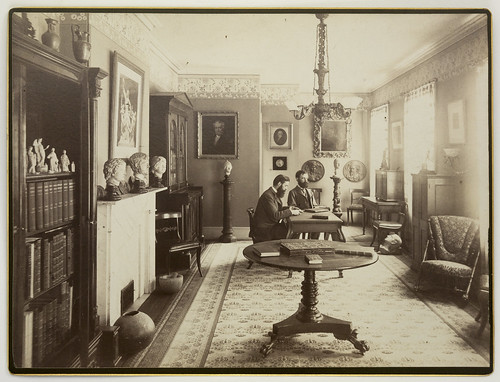
Sale 108 is the Dr. Ferdinando Bassoli library Consisting of antiquarian numismatic books and classic works on Italian numismatics. Both sales will take place Saturday, January 10, 2009. Illustrated below is lot 153: Echel, Joseph. DOCTRINA NUMORUM VETERUM, First edition 1792-1798, Eight volumes complete.
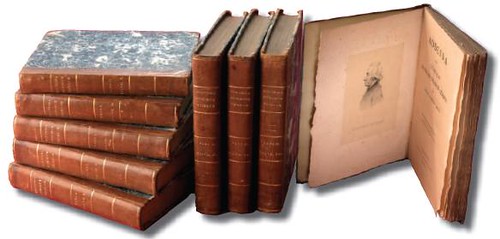
BOOK REVIEW: AMERICAS MONEY, AMERICAS STORY BY RICHARD DOTY
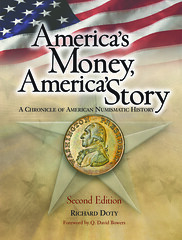 Richard Doty, head curator of the National
numismatic collection at the Smithsonian Institution has written the
second edition of his observations on the history of Americas
money.
Richard Doty, head curator of the National
numismatic collection at the Smithsonian Institution has written the
second edition of his observations on the history of Americas
money.From the beginnings of our economic symbols from wampum up through our bullion coins, Mr. Doty has kept the reader informed and entertained in his inimitable style. The reader is treated to an account of attempts to counterfeit wampum by staining it with berry juice! In another section, the reader is informed that the leaf prints on Americas first paper money were actually a counterfeit deterrent, as the skeletons of leaves are much like fingerprints. Each is unique. This thread of the history of counterfeiting is one theme that weaves its way through the history of our money up to the colorization of todays paper denominations. It would seem in conclusion that everything old is new again.
In and among these anecdotes are tidbits of information such as the various items that were traded monetarily. These include tobacco, (providing one could corner the market and thus control the production of this noxious plant), nails, and the like. All of these have a place in the history of Americas money and the point is made that all of these are just as important as the coins and paper money that literally rolled out of the mint.
Doty goes on to mention the cause and effect of various money manufacturing methods. He makes these rather mundane subjects quite fascinating. One section of this updated volume is devoted to the paper money technology of Jacob Perkins. (I will spare the details here so that there can be something to look forward to when one purchases this book.) Suffice it to say here that this section is worth the whole price of this volume.
Along with the pictures and vignettes of the various coins and specimens of paper money, Doty presents a concise history of banking in America and discusses the various economic upturns and downward spirals in our monetary history. One can hardly discuss the money of our country without discussing the economy tied in with its manufacture.
One aspect of our monetary history that is missing, from this readers standpoint at least, is a discussion of the devaluation of our basic coinage, beginning in 1795 when the large cent and half cent were made half as thick. Half the copper was taken out, again as a result of the world market for copper. Copper was devalued on the world market and so our coins were thinned out Again devaluation would take place in 1856 with the tiny (by comparison) flying eagle cent, and yet again in 1981 when the cent was made of copper coated zinc! Such mention of this devaluation reflective of the cost of metal on the world market and its effects on our hobby would have made this volume perhaps a bit more complete.
Doty has made history an exciting subject for any reader with his presentation of this subject as illustrated by Americas coins and paper money. The budding numismatist will find his or her newfound interest in our money more enriched by reading this volume. The more seasoned collector will find a wealth of information at the fingertips.
The illustrations show Americas money at its collective best. The balance between illustration and text is maintained quite well; one does not overly detract from the other, but rather each augments the understanding of the other.
There is something for everyone in this book, whether the person reading is an appreciator of fine art, a historian, or a technology buff.
In short, this book celebrates Americas rich monetary history even during this period of economic downturn. It is highly recommended even for non numismatists.
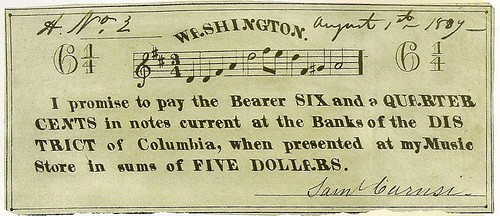
The book abounds with delightful image choices, including typewritten 1933 New York depression scrip and the Pismo Beach clamshell dollar. It's not just a pretty picture book, though - the text is excellent, making this another one of the select few numismatic books that aren't just for reference, but for actually sitting down and reading. -Editor
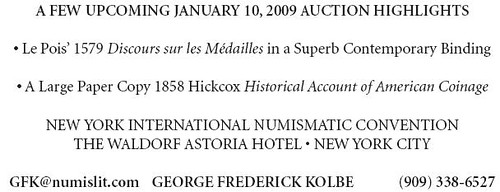
MORE ON THE ECONOMICS OF NUMISMATIC BOOK PUBLISHING
David Lange writes:MORE ON CRANKY BOOKSELLERS
Dick Hanscom writes:I was again home visiting my mother in Newburyport, Massachusetts, and was looking to find an issue of Yankee magazine. On other trips, I had noticed that his sign said he had magazines. So, I drove up to Portsmouth, to be greeted with a sign on his door: "This is a limited access store. There is a $5 admission." The $5 may not be correct. It may have been more! Needless to say, I turned around and drove back to Newburyport. Perhaps I should have paid the $5, and hung around for a few hours, but I didn't have the time.
IRASCIBLE COIN DEALERS
Art Kelley dealt in coins out of a shop full of antiques on St. Louis's Olive Street, operating as Kelley's Antiques. His pet peeve was two customers in his shop at the same time speaking to each other. Should one of these say so much as a "hello" to the other would earn a tongue-lashing from the proprietor. You spoke to him, and him alone, absolutely no fraternizing on his premises.
He had a kitchen in the back of his shop, and after he got to know you, you could be invited there for perhaps a cup of coffee. But even here you could not speak to anyone else in the inner sanctum. Even as president of the Missouri Numismatic Society (St. Louis's only coin club) I often wanted to speak up to invite a fellow customer to attend a coin club meeting. But after being on the receiving end of only one Kelley tirade I learned to keep quite as required.
One time, however, I circumvented this requirement. "Hey, Art, why don't you come to the coin club meeting at the Roosevelt Hotel" and I named the date of the next meeting, even knowing in advance he would never attend. But I got the point across to my tacit associate.
Gosh, that happened fifty years ago. I hope E-Sylum readers don't mind a little reminiscing from an old-timer who has been around a lot in the numismatic field, dare I say the coin world?
THE BOOK BAZARRE
MORE ON SCULPTOR ALPHONSE ANTON KOLB
Ken Barr writes:Marc Charles Ricard writes:
I would also direct anyone who would like to learn more about Mr. Kolb and his works to the TAMS Journal, August 1973, Volume 13, #4, Part II. This special supplement was written by Charles J. Ricard, and includes many works from Mr. Kolb's private collection in his home, some of which had never been photographed and published before or since. Although Alphonse Kolb was well-known regionally, it is my sincere hope that medalists and collectors across the country will be able to admire and share his wonderful gift for generations to come.
Ed Reiter writes:
By then, our roles were reversed: Whereas Alphonse, the native German, had put down deep roots in "The Flower City," I, the native Rochesterian, had resettled in New Jersey. But we shared a German heritage and a zest for numismatics -- particularly numismatic art.
As I recall, I visited Alphonse twice during trips back to Rochester. The first time, I interviewed him for "Who's Who in the Hobby," a feature I wrote for Numismatic News profiling interesting coin hobbyists. The second time, I photographed him at work for an article in COINage. The COINage article appeared in the May 1983 issue.
Sadly, however, Alphonse had died March 30, shortly before the issue reached readers. (As those who have written for magazines know, monthly publications use cover dates weeks ahead of their release dates in order to extend their potential newsstand shelf life.)
I also wrote a posthumous tribute to Alphonse in my weekly "Numismatics" column in The New York Times. This appeared on Sunday, May 15, 1983.
Here are some excerpts from Ed's New York Times article:
Recently, Mr. Kolb contributed $10,000 to the Rochester Museum and Science Center with the proviso that the museum continue to provide facilities for the club's twice-monthly meetings and its library.
Mr. Kolb, who died March 30 at the age of 89, designed the annual medals issued by the club to honor its outgoing presidents. One of these was a self-portrait which the sculptor made in 1931 while serving as the club's president. He also designed medals for special occasions including the club's 500th, 700th and 1,000th meetings and its 25th, 35th, 50th, 60th and 70th anniversaries. For the most part, this work was a labor of love done without compensation.
''Alphonse has been a unifying force and an irreplaceable person,'' said John Jay Pittman, a past president of the club who also has been president of the American Numismatic Association and the Canadian Numismatic Association.
Alphonse Kolb was born in Gmund, Germany and learned the basics of engraving during his teens when he was apprenticed to the owner of a jewelry manufacturing establishment in that town. ''I kept improving and going into finer work until finally I got into sculpture,'' he once recalled.
At 19, he left home to seek a position in Hamburg, but wanderlust impelled him to board a ship for New York. A year later he settled in Rochester, a city with a strong German heritage. It was also a center for artisans. There Mr. Kolb took a position as a designer and diecutter for Bastian Brothers, a well-known producer of medals. He held that post for a number of years while accepting private commissions.
Mr. Kolb did much to capture Rochester's history in medallic art. His work includes medals, sculptures, historical tablets and other works of art chronicling the city's development and its leaders. His finest single work was the Rochester Civic Medal, a silver three-inch medal given each year by the city museum to outstanding civic leaders.
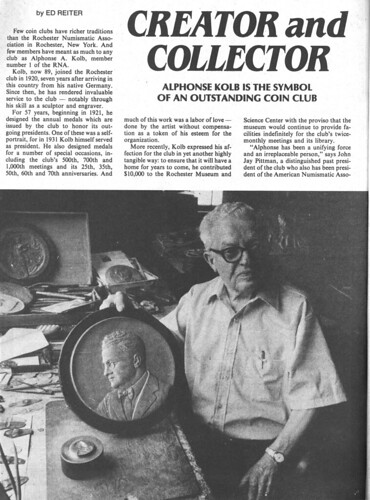
MORE ON THE 1838-O HALF DOLLAR
The 1838 Mint Report states that 367,434 dimes were struck before operations were halted from the end of July to the beginning of November so that the officers could leave New Orleans during the "sickly season". The Report concludes by reporting that a total of 402,430 dimes (and no other denominations) were minted in New Orleans in 1838.
The 1839 Mint Report comes in two parts. The page that Mr. Lupia submitted is the first page of the second part.
The first part of the report, dated January 30, 1840, states: "The coinage at the New Orleans branch mint, up to the 17th of August, when operations were suspended, amounted to $227,160 in silver, composed of 2,401,600 pieces of coin."
It also discusses "disagreements. . .among the officers" and reports on the investigation by the "United States district attorney at New Orleans". Table D, which shows the coinage of the branch mints in 1839, details mintage of 100,000 half dollars, 1,241,600 dimes and 1,060,000 half dimes at New Orleans.
As we saw in the scan of the second part of the 1839 Mint Report last week, the Report stated that in November and December, the New Orleans Mint coined $23,490 in gold and $13,000 in silver, consisting of 9,396 quarter eagles, 16,000 half dollars and 50,000 dimes.
Fortunately, while that is all the information in the Mint Annual Reports, we can look to RW Julian's research for more details. He published an excellent article about the early years of the New Orleans Mint in the September 1968 issue of The Numismatic Scrapbook Magazine. In it, he reports that no half dollars were delivered by the Coiner of the New Orleans Mint in 1838 and he believes that the 1838-O half dollars were minted in late March or early April 1839, as the first reported delivery is of 64,000 half dollars on April 6, 1839. Mr. Julian also reports that the 1838-dated obverse dies were defaced on June 13, 1839. In addition, he states that while he hasn't found any documentary evidence, he has no reason to doubt that 20 1838-O half dollars were struck.
By the way, additional versions of Mr. Julian's article exist: one was published in the November 1977 issues of Coins magazine (although without the detailed tables of the Scrapbook article). Also, I infer from Randy Wiley's article in issue #99 of The Gobrecht Journal that additional versions were published in Numismatic News on May 27, 1986 and March 4, 1997. (Clearly, it's time for Mr. Julian to meet his once-a-decade schedule and re-publish the article again!)
MORE ON THE U.S. MINT'S FIRST STEAM-POWERED COIN PRESS
Regarding Dick Johnson's mention of the U.S. Mint's first steam press, John Dannreuther writes:MORE ON EBAY BUYER COMMENTS
No tie-less wide lapels or sneakers at this race day. Ermine bindles abundant.
Stylish duo caught on CCTV but the falcon did not land in the nest!
Just to make sure I wasnt being singled out with some back bush rhetoric, I checked up on what feedback this character has left for others. Perhaps Messrs Nobel or Pitchfork, the latter I know being an Esylum reader, can tell us what they put in the water down there?
Fidel Castro celebrated his gre-art birthday celebration with a fine ravioli.
Lituus and capis for this man! The rostra couldn't match this imPECKable service
Another such victory and I shall be Kun-dun!
Gre-art art guys ... I'm on the ferry right now just to pay my compliments!
Tribute of 300 talents and supplication to a stand-up buyer.
Hercules reincarnated entered the arena, club in hand, and ended an era.
Happy transaction - Propped up by dinner suit despite falling on hard times.
Even Omar be trippin' over this dope-down package
MILF Island became the Field of Ma's on account of this great historical service
Seller has the fastest postage in the southern hemisphere in his age group!
Quick and relaxed transaction - all the ceremony was left for the Olympics!
Heinous Hillary having heavenly hindsight not hindering hospitability to hear.
Balmy Obama doesn't balk at bountifully ebullient bit bargain.
Meditations and musings about digestivo bar in East Sydney - bellisimo.
THE BOOK BAZARRE
TOWN FIGHTS CUBA'S DUAL CURRENCY SYSTEM
Dick Johnson writes:How this works in practice is spelled out in an article in a Jamaican newspaper, Jamaica Gleaner, published Sunday, November 9th. It reveals how one tourist town plays the Cuban Currency Caper game.
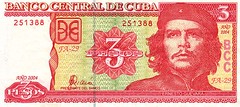 An experiment in the eastern city of Bayamo is
letting average government workers enjoy a few things only foreigners and
monied Cubans usually can afford: a good burger, a kicking jazz bar and
stiff cocktails.
An experiment in the eastern city of Bayamo is
letting average government workers enjoy a few things only foreigners and
monied Cubans usually can afford: a good burger, a kicking jazz bar and
stiff cocktails.Across the rest of the island, monthly government salaries of 408 pesos, about US$19.50, don't cover grocery bills, let alone a night out.
But in Bayamo the central government has made a special effort to support peso businesses, giving the lowly currency actual buying power.
"Almost everyone who comes in is surprised at first. The music is good. The cocktails are strong," said Ernesto Aldana of the Piano Bar, where the Cuba Libre - copious rum pours with ice and splashes of cola and lime - costs 4.80 pesos, the equivalent of less than 25 cents.
"It's like you're paying in dollars," Aldana said. "But, you're not."
Despite the hurricanes and rising food prices, the Bayamo experiment is so successful that the central government in Havana is continuing to devote US$10 million this year to reopen some peso businesses and cover operating expenses of those already established, Alonso said.
There are ordinary peso businesses all over Cuba, but the pro-ducts are shoddy and service is mediocre. Shortages of everything from potatoes to pasta mean most of the dishes listed on peso restaurant menus are not available, while peso stores have long lines of customers for mismatched inventory on largely empty shelves.
Contrast that with Bayamo, where the raw juice bar offers freshly squeezed mango or papaya juice for the equivalent of less than a nickel. The fully stocked dairy stays open until 11 p.m. on Saturdays. Ground beef is often hard to come by elsewhere, but here two hamburger joints serve up double patties heaped with ham for about US$0.40 in pesos.
To read the complete article, see: Experimenting with the peso: One town's experiment gives Cuban peso real value (http://www.jamaica-gleaner.com/gleaner/20081109/business/business7.html)
OHIO CASH HOARD DISPERSED
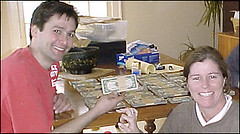 In the end, a contractor who found $182,000 in
Depression-era currency hidden in bathroom walls received just a few
thousand dollars and, he feels, some vindication.
In the end, a contractor who found $182,000 in
Depression-era currency hidden in bathroom walls received just a few
thousand dollars and, he feels, some vindication.The discovery amounted to little more than grief for the contractor, Bob Kitts, who could not agree on how to divide the money with the homes owner, Amanda Reece.
As for the 21 descendants of Patrick Dunne a wealthy businessman who stashed money that was minted in a time of bank collapses and joblessness, only to have it divvied up decades later in a somewhat similar economic climate they will each get a small fraction of the find.
I called it the greed case, said Gid Marcinkevicius, a lawyer who represents the Dunne estate.
If these two individuals had sat down and resolved their disputes and divided the money, the heirs would have had no knowledge of it, Mr. Marcinkevicius said. Because they were not able to sit down and divide it in a rational way, they both lost.
Mr. Kitts, who called his discovery the ultimate contractor fantasy, was tearing out the bathroom walls of an 83-year-old home near Lake Erie on a spring day in 2006 when he discovered two green lockboxes suspended by a wire below the medicine chest. Inside were envelopes with the return address for the P. Dunne News Agency.
I ripped the corner off of one, Mr. Kitts said in a deposition in a lawsuit filed by Mr. Dunnes estate. I saw a 50 and got a little dizzy.
Inside the envelopes was $157,000. And a cardboard box in another wall held about $25,000.
To read the complete article, see: Found: $182,000 and a Lot of Grief. Glee Turns to Grudges and a Court Battle Over Dividing the Stash (http://www.washingtonpost.com/wp-dyn/content/article/2008/11/08/AR2008110802248.html)
1915 PAN-PAC EXPO LEGACY: THE WORLD'S SMALLEST ENGRAVINGS
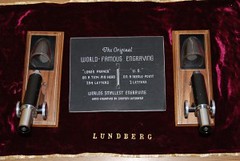 It took master engraver Godfrey Lundberg three
years (1913-1915) to painstakingly inscribe the twelve lines, 65 words and
254 letters of the Lord's Prayer on the head of a smaller than usual gold
pin. To this day, this rare antique hand engraving accomplishment has yet
to be surpassed.
It took master engraver Godfrey Lundberg three
years (1913-1915) to painstakingly inscribe the twelve lines, 65 words and
254 letters of the Lord's Prayer on the head of a smaller than usual gold
pin. To this day, this rare antique hand engraving accomplishment has yet
to be surpassed. Carefully preserved and locked away for decades this rarity has been passed down within the Lundberg Family from generation to generation. A new website has recently been launched to tell the remarkable story of these rare antique collectible engravings. Visit http://www.antique-engravings.com/
The extraordinary miniature engravings collection actually includes two separate items; the Lord's Prayer cut into the head of a gold pin and a two-letter monogram of the abbreviation of the United States "U.S." engraved into the point of a fine gold sewing needle.
 After their debut at the San Francisco World's
Fair in 1915, the rare engravings went on a national tour accompanied by
two of Godfrey's brothers, Carl and Mauritz Lundberg. Over the course of
two years and 43 states the traveling exhibit visited clothing stores,
expositions, town halls and newspaper offices where curious observers paid
25 cents to view the engravings through mounted microscopes for
magnification. The engravings were reported to have been "verified by
engravers from coast to coast."
After their debut at the San Francisco World's
Fair in 1915, the rare engravings went on a national tour accompanied by
two of Godfrey's brothers, Carl and Mauritz Lundberg. Over the course of
two years and 43 states the traveling exhibit visited clothing stores,
expositions, town halls and newspaper offices where curious observers paid
25 cents to view the engravings through mounted microscopes for
magnification. The engravings were reported to have been "verified by
engravers from coast to coast." As testimony to the unusual nature of the "smallest piece of engraving in the world" the leading authority on the odd and bizarre, Ripley's Believe It or Not, featured the pin in its popular publications.
According to a February 21, 1915 article in the "Spokesman-Review" Newspaper Lundberg spent three years engraving the Lord's Prayer on the head of a smaller than ordinary pin. The hand engraving artwork was so tedious that he had to forgo coffee and alcohol and undergo a training regime worthy of a professional athlete to tone his body and muscles. Lundberg found that the only time he could work was in the early hours of the morning in his shop at 394 Sprague Avenue in Spokane, WA. The least jar from traffic on the pavement outside could ruin his work. As it was he could not make more than two or three strokes during a night's work.
His dedication and skill to create this rare miniature engraving was was ultimately rewarded with a gold medal at the 1915 Pan-Pacific Exposition in San Francisco.
To read the complete press release, see: Over Eighty Years in a Bank Vault - The World's Smallest Engravings Are Once Again Revealed to the Public (http://www.prweb.com/releases/2008/11/prweb1571204.htm)
WAYNE'S NON-NUMISMATIC DIARY NOVEMBER 9, 2008
Nothing truly numismatic to report this week since I was away on holiday with my family. We went to Orlando, FL and spent three of the days at Walt Disney World. I suppose I could have written a report on the elongated coin-making machines scattered throughout the parks, but I was afraid to start - the numismatic researcher in me would have ended up buying one of each coin design and compiling a detailed list of where each machine was located. One interesting thing to note - these machines don't just press cents - at least one would press a design onto a quarter.One semi-numismatic tidbit was the magic trick I dreamed up on the fly to entertain our kids at lunch breaks. Four-year-old Hannah insisted on seeing a magic trick after eight-year-old Tyler started pulling pennies out of her ear. I almost regret teaching him that one, since he spent the vacation pulling pennies, French fries and everything else out of people's ears.
Knowing that girls key onto things like people and relationships, I made use of the fact that Abe Lincoln's bust faces the opposite direction of the other portraits. I put a Lincoln cent and Jefferson nickel in my hand, lining the portraits up back-to-back. I told her the people were mad at each other and not talking. I closed my fist, asked her to say the magic words "Abracadabra, please be friends!", and when I opened my hand Abe and Jeff were now looking at one another. "Now they're friends!" she exclaimed, and I had to repeat the trick over and over all week.
As a numismatist I already walk a path less travelled. I like it that way - getting away from the crowds is where some real gems await.
On Friday we took a tourist path less travelled, visiting Cypress Gardens. It turned out to be the path REALLY less travelled. Arriving at the park opening, our rental van was one of just a couple dozen vehicles in the parking lot. Waiting to inspect our bags was Art (we're on a first-name basis). Art was the only inspector, and there was no line whatsoever. There was one ticket seller. Again, no line.
The old-time Florida park was eclipsed long ago by Disney and its ilk, yet somehow it manages to hang on. And that's a good thing - the park has its charm and was a delight to navigate sans shoulder-to-shoulder crowds. One of the charms was the toothless woman operating one of the kiddie rides.
But our kids didn't notice or care. They could ride again and again with no lines, and had an absolute ball. Older kids (and a lot of adults) would find the park lame, but for our crew (aged 9, 8 and 4) it was a dream come true. Hannah would grab me by the hand and literally drag me onto the next ride, and the boys were so excited they ran full speed between rides.
We also enjoyed strolling through the zoo area and seeing the park's animal show and Pirate and Cowboy comedy shows. Corny, but actually pretty entertaining. No blockbuster soundtrack or choreography, but good clean fun just the same. Although a little run down at the edges, most of the park was new and clean. If you have a sense of humor, you'll enjoy it.
I'll never forget the lunchtime experience. The hostess (I'll call her "Hazel") was a one-woman show. She took our order at one end of the counter, then walked over to the other side to prepare it. She put pizzas in the oven, cut them when they came out, made sandwiches, and poured drinks. All this took about 20 minutes. My kids were hungry, my wife was steamed, but I couldn't help but grin at the down-home quirkiness of it all. In the end our lunch was good (thanks, Hazel) and we were in no real hurry - we didn't have to be.
We ended up seeing the same sets of families all around the park, giving it the homey feel of a company picnic. The park closed at 5pm and we missed one of the core attractions, the botanic gardens. But the rest of the grounds were beautiful, too, being dotted with Cypress trees decked out with Spanish moss. So consider Cypress Gardens if you're visiting Florida with small kids or grandkids, and be prepared for a very anti-Disney experience.
KRALJEVICH TAKES THE GRAND TOUR OF EUROPE
In other vacation news, John Kraljevich writes: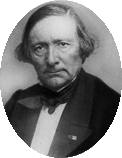 I just got back from a bibliophilic/numismatic tour
of a piece of Europe, including a book fair in Amsterdam, a book and paper
show in Paris, and a quiet appointment with Alexandre Vattemare's U.S.
collection at the Bibliotheque Nationale. It was a really, really fun
time.
I just got back from a bibliophilic/numismatic tour
of a piece of Europe, including a book fair in Amsterdam, a book and paper
show in Paris, and a quiet appointment with Alexandre Vattemare's U.S.
collection at the Bibliotheque Nationale. It was a really, really fun
time. GARDEN STATE PARKWAY TOKEN LATEST VICTIM OF TECHNOLOGY
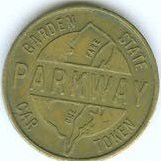 Here's the checklist for your next visit to the
National Museum of American History:
Here's the checklist for your next visit to the
National Museum of American History:Ruby slippers from "The Wizard of Oz."
The contents of Julia Child's kitchen.
A draft of the Gettysburg Address.
Garden State Parkway tokens.
Well, maybe not right away for the last one.
However, the New Jersey Turnpike Authority sent a dozen of the tokens - which will no longer be accepted on the parkway as of Jan. 1 - to the Smithsonian Institution-run museum in Washington, D.C., on Monday. The tokens were dispatched to the museum after turnpike authority officials thought they would check with Smithsonian officials to see if they were interested in having some.
"They agreed," authority spokesman Joseph Orlando said.
Orlando acknowledged only a small percentage of the museum's collection is on display, so he doesn't think the tokens will wind up next to the Hope Diamond display anytime soon.
"At some point, they might be on display," he said.
The tokens were accompanied by a brochure that was distributed when the tokens went on sale in 1988.
Tokens also have been sent to the official state archives and the American Numismatic Society.
The tokens, which were sold as part of a discount toll operation, were a success in their day: Motorists bought about $2 billion worth of them from 1988 to the end of 2001, the last year they were sold. There were about 50 million of them in 2001.
Orlando said the turnpike authority estimates there are about 5 million of the tokens still in circulation.
As the sun sets on the tokens, the turnpike authority is giving token holders one last chance during December to turn the tokens in for cash.
To read the complete article, see: Garden State Parkway tokens to become a thing of the past (http://www.pressofatlanticcity.com/186/story/305231.html)
REWARD OFFERED FOR RETURN OF STOLEN STEWARTBY SCOTTISH COIN COLLECTION
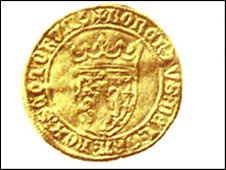 A 50,000 reward has been offered for the return of a
"unique" collection of Scots coins stolen last year. They were taken from
the home of Lord and Lady Stewartby at Broughton in the Borders and are
worth about 500,000.
A 50,000 reward has been offered for the return of a
"unique" collection of Scots coins stolen last year. They were taken from
the home of Lord and Lady Stewartby at Broughton in the Borders and are
worth about 500,000. The items have been described as the most important collection of early Scottish coins ever assembled with some dating back nearly 900 years. A reward has now been offered for any information which leads to the return of the coins to their rightful owner.
The theft took place overnight between 6 and 7 June 2007. The collection had been amassed by Lord Stewartby over a period of some 50 years.
Nick Holmes, senior curator of numismatics at the National Museum of Scotland, said the coins were of huge importance.
"This collection is a unique part of Scottish history and the impact of its loss cannot be overstated," he said.
A police spokesman said: "The coins are unsellable on the market because they are so well known, and dealers and others in the coin trade have been checking the source of any early Scottish coins that appear for sale.
To read the complete BBC News article, see: 50,000 reward in coin theft hunt (http://news.bbc.co.uk/2/hi/uk_news/scotland/south_of_scotland/7705730.stm)
To read the complete Telegraph article, see: 50,000 reward for stolen coin collection (http://www.telegraph.co.uk/news/newstopics/politics
/scotland/3371434/50000-reward-for-stolen-coin-collection.html)
UNIQUE PROOF 1844-O EAGLE TO BE EXHIBITED AT THE NEW ORLEANS MINT
In 1844, the New Orleans mint produced at least one example of a Proof half eagle and eagle. Remarkably, both still exist and, even more remarkably, both are superbly preserved. Why were they produced and who were they struck for?
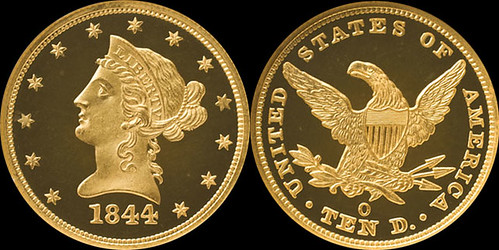
Unfortunately, contemporary documentation does not exist that gives the definitive answer to these questions, so we have to make some assumptions. I think its safe to say that the Proof 1844-O gold set was struck in commemoration of either a special event or, more likely, a visit to the Mint by some special VIP or dignitary. My guess would be that they were made for personal presentation to President John Tyler.
The earliest numismatic reference to the 1844-O Proofs appears to be in the Seavey descriptive catalog that was published in 1873. In 1890 when they were sold as part of the famous Parmelee collection the eagle sold (as Lot 1151) for the princely sum of $16 while its companion half eagle brought just $9.50. It was next seen in the collection of William Woodin who was famous both as a coin collector and as Secretary of the Treasury for Franklin D. Roosevelt in 1933.
Woodin sold his primary collection at auction in 1911 but I am not aware if the Proof 1844-O set was included in either of his two sales (it would be easy to check these in the sale catalogs but my library does not contain them). It is documented that Woodin also sold many of his coins privately to the leading collectors and dealers of the day. I do not know this with certainty but I surmise that the 1844-O Proofs went into the Brand collection.
From here on, the pedigree chain for the 1844-O half eagle and eagle gets murky. In fact, I think it is possible that the coins were split up when the Brand collection was being sold in the 1920s and 1930s.
The half eagle was in all likelihood sold to Waldo Newcomer and then likely went into the Colonel Green collection. From there it is believed to have been sold to King Farouk and remained in this collection until it was forcibly sold at auction in 1954. It was later sold to a prominent Texas collector (not Harry Bass, by the way...) by Abe Kosoff in 1959. I was shown the Proof half eagle in the early 1990s by the Texas dealer Michael Brownlee. It was still in the original flip with Kosoffs writing on it. I used it as the cover coin of the first edition of my New Orleans book.
To read the complete article, see: Douglas Winter Market Report November 5, 2008 (http://www.raregoldcoins.com/market_report211.asp)
To read the complete PCGS forum thread, see: Longacre, did you loan this gold coin to the New Orleans Mint? (http://forums.collectors.com/messageview.cfm?catid=26&threadid=686997)
ARTIST CREATED ICELANDIC NOTE THAT DOESN'T EXIST
The story goes... that an opportunistic gentleman went into a Reykjavik convenience store on Monday and paid for his shopping with a 10,000 kronur note. Eye brows should have been raised instantly.
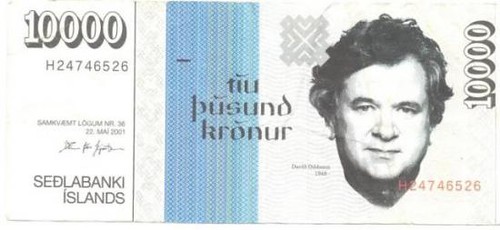
There is no such thing as a 10,000 kronur note in Iceland (yet). The biggest denomination is 5,000kr, and all Icelandic notes feature important historical figures from the countrys past. The new counterfeit note featured the face of current Central Bank chairman, David Oddsson.
The shop sales clerks were apparently not quite awake. Almost incredibly, the note was accepted without question, and the man got around 7,000kr back in change!
To read the complete article, see: Comedy criminal rewarded by stupidity (http://www.icenews.is/index.php/2008/11/06/
victim-deserved-it-criminal-officially-comic-genius/)
A piece from the final project of art student dinn Thr Kjartansson for the Iceland Academy of the Arts, namely fake ISK 10,000 banknotes bearing a picture of Central Bank governor and chairman Davd Oddsson, was passed off as viable currency at a Reykjavk grocery store.
Kjartansson displayed two full bags of the fake banknotes at Kjarvalsstadir Art Museum last spring and had spread some on the floor in front of the bags.
There were around 20,000 fake banknotes in total and Kjartansson said he was aware of that some guests had taken banknotes with them as a souvenir.
Of course Im sorry to hear that people are abusing my artwork, although it isnt such a serious crime considering the amounts some people are stealing nowadays, Kjartansson said, adding that the crime puts his artwork in a new context and gives it a new dimension. It gives it more life and value. And is also a little funny.
To read the complete article, see: Artwork Used as Couterfeit Banknote in Store (http://www.icelandreview.com/icelandreview/
daily_news/?cat_id=16539&ew_0_a_id=315004)
ZIMBABWE'S CENTRAL BANK INTRODUCES EVEN BIGGER BANKNOTES
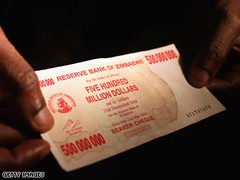 Zimbabwe's troubled central bank introduced $100
billion banknotes Saturday in a desperate bid to ease the recurrent cash
shortages plaguing the inflation-ravaged economy.
Zimbabwe's troubled central bank introduced $100
billion banknotes Saturday in a desperate bid to ease the recurrent cash
shortages plaguing the inflation-ravaged economy.The bills officially come into circulation Monday, although they were on the foreign currency dealers market Saturday. As high as they are, though, the bills still aren't enough to buy a loaf of bread. They can buy only four oranges. The new note is equal to just one U.S. dollar.
Once-prosperous Zimbabwe has seen an unprecedented economic meltdown since it gained independence in 1980, with the official inflation rate now at 2.2 million percent.
To read the complete article, see: Zimbabwe introduces $100 billion banknotes (http://edition.cnn.com/2008/WORLD/africa/07/19/
zimbabwe.banknotes/index.html)
ARTICLE: WOMAN USES "RARE" COINS FOR PURCHASE
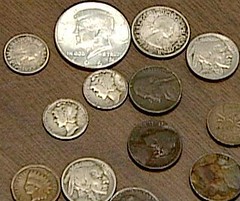 Lancaster state police in Pennsylvania are
looking for a woman who used rare and unusual coins to pay for cigarettes
at a Turkey Hill market, WGAL reported.
Lancaster state police in Pennsylvania are
looking for a woman who used rare and unusual coins to pay for cigarettes
at a Turkey Hill market, WGAL reported.The woman used a 1964 silver half-dollar, a silver dime, four mercury dimes, three Indian head nickels, three other rare nickels, a wheat penny and three silver foreign coins, troopers said.
"It's not a crime to present old coins to buy something at a store, but we would be interested to know if in fact the coins came from a theft or burglary or simply owned by an individual who wanted to get rid of them," said Cpl. John Duby of the Pennsylvania State Police.
To read the complete article, see: Woman Uses Rare Coins For Purchase (http://www.wapt.com/news/17875924/detail.html)
FEATURED WEB PAGE: FRATERNAL ORGANIZATIONS IN AMERICA
This week's featured web page is suggested by John and Nancy Wilson, who write:www.phoenixmasonry.org/masonicmuseum/
fraternalism/chronology_fraternal_
organizations_america.htm
